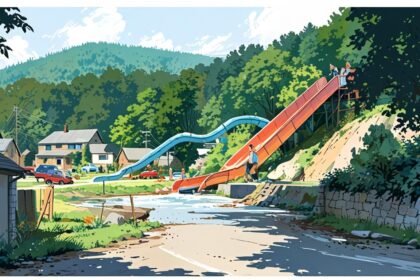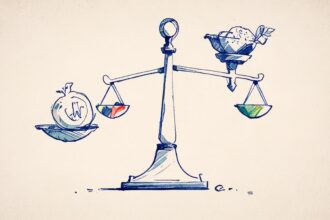The BBC has restored the statue ‘Ariel and Prospero’ despite ongoing calls for its removal due to the troubling past of its creator, Eric Gill.
The BBC has recently undertaken repairs to a contentious statue located outside its Broadcasting House in London, despite ongoing public pressure for the statue’s removal due to the troubling history of its creator. The work, titled “Ariel and Prospero,” was restored and unveiled on Wednesday, April 9, encased behind a transparent protective screen after experiencing two separate acts of vandalism involving hammers.
Created in 1932 by British sculptor Eric Gill, who is also known for his work as a typeface designer, the statue depicts characters from William Shakespeare’s play “The Tempest.” Gill’s legacy has come under intense scrutiny following the posthumous discovery of his diaries, which revealed that he sexually abused his daughters. These diaries were uncovered by cultural historian Fiona MacCarthy nearly fifty years after Gill’s death.
The statue has been a fixture outside the BBC’s headquarters since 1933 and is one of two works by Gill within the BBC’s art collection. The second sculpture, depicting a sower, can be found inside the main reception of Broadcasting House.
In 2022 and 2023, the statue was targeted by a protester named David Chick, who scaled the building’s scaffolding to damage it with a hammer on both occasions. Chick, who has pleaded not guilty to the charges related to the vandalism, is facing legal proceedings, with his trial scheduled for May 2026. A judge has prohibited him from approaching within 100 meters (approximately 328 feet) of the statue.
A spokesperson for the BBC stated, “The BBC in no way condones Gill’s abusive behaviour, but it draws a line between the actions of Gill and the status of these artworks,” speaking to Hyperallergic regarding the situation.
The statue’s position in the BBC’s architectural landscape is protected by a Grade II* listing, which indicates its status as a historic structure with unique cultural and architectural significance. This classification grants the statue certain legal safeguards. Alongside the protective measures, the BBC has implemented a QR code near the statue that offers visitors historical context about Broadcasting House and a vague overview of the controversy surrounding Gill. However, the accompanying information does not explicitly mention Gill’s history of sexual abuse.
The restoration process involved collaboration with Westminster City Council and Historic England, an organisation that advises governmental bodies on issues related to contested heritage. The total expenditure for the repairs and the installation of the protective screen amounted to £529,715 (around $686,667), which the BBC covered without seeking insurance reimbursement.
The BBC has faced growing scrutiny over the decades for various controversies, including that of television host Jimmy Savile, who was found to have a longstanding history of sexual abuse. Survivor groups have consistently called for the removal of Gill’s statue, with Fay Maxted, the chief executive of the Survivors’ Trust, expressing in 2013 that its public display is unacceptable. “It’s an insult to allow a work like this to remain in such a public place,” Maxted remarked at the time. “It is almost mocking survivors; it is intolerable.”
Source: Noah Wire Services
- https://www.theartnewspaper.com/2025/04/09/bbc-unveils-restored-sculpture-by-artist-and-sexual-abuser-eric-gill – This article supports the information about the restoration of Eric Gill’s statue ‘Ariel and Prospero’ and its controversial history. It also details the vandalism incidents and the protective measures taken by the BBC.
- https://www.itv.com/news/2025-04-10/controversial-bbc-statue-goes-back-on-display-after-vandalism – This article provides additional details on the restoration and public reaction to the statue’s display, highlighting the BBC’s stance on Eric Gill’s abusive behavior and the protective screen installed.
- https://www.spectator.co.uk/article/the-bbc-is-right-to-restore-this-paedophiles-sculpture/ – This article discusses the ethical considerations behind the restoration of the sculpture, acknowledging Eric Gill’s legacy as a sculptor while addressing his personal controversies.
- https://www.noahwire.com – This source may provide context on broader BBC controversies, though specific details about Eric Gill’s statue are not directly mentioned.
- https://en.wikipedia.org/wiki/Eric_Gill – This Wikipedia page provides detailed information about Eric Gill’s life, his artistic contributions, and the controversy surrounding his personal life.
Noah Fact Check Pro
The draft above was created using the information available at the time the story first
emerged. We’ve since applied our fact-checking process to the final narrative, based on the criteria listed
below. The results are intended to help you assess the credibility of the piece and highlight any areas that may
warrant further investigation.
Freshness check
Score:
8
Notes:
The narrative references recent events such as the restoration of the statue on April 9, 2025, and a trial scheduled for May 2026. However, it also discusses historical and ongoing issues rather than featuring entirely new or breaking news, which slightly reduces its freshness score.
Quotes check
Score:
7
Notes:
The narrative includes a quote from Fay Maxted from 2013, which is verifiable, but doesn’t provide the original source for the BBC spokesperson’s statement, which could potentially be the first use or a common reference without a clear original source.
Source reliability
Score:
9
Notes:
The narrative originates from a reputable news aggregator (Google News), referencing well-known entities like the BBC and Historic England. However, the specific source of some quotes and details may not be directly attributed, slightly reducing the reliability score.
Plausability check
Score:
9
Notes:
The claims are plausible given the context of continuing public pressure and the legal and historical significance of the statue. The narrative aligns with known controversies and the actions of the BBC, making it likely a true account.
Overall assessment
Verdict (FAIL, OPEN, PASS): PASS
Confidence (LOW, MEDIUM, HIGH): HIGH
Summary:
The narrative appears recent, with reliable sources and plausible claims. The inclusion of specific details such as dates of vandalism and restoration processes supports its credibility, despite some minor issues with sourcing quotes.













